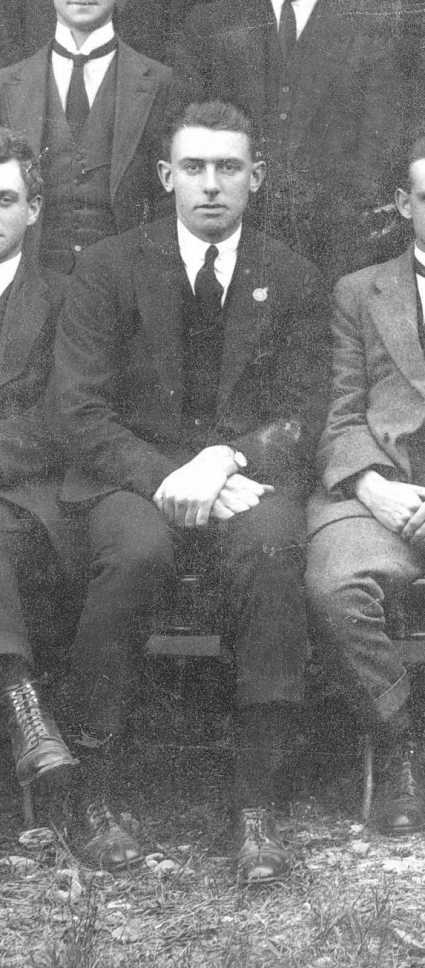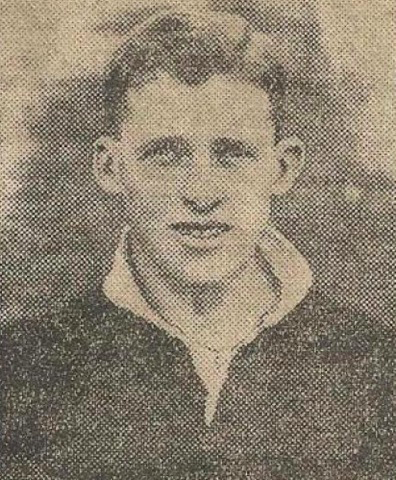6 June 2022 marks 100 years since the death of Robert Elliot Shute, the man who the Shute Shield is named after.
The tragic origin of the Shute Shield is well known. In 1922 a Sydney University prop forward, 23-year-old Robert Shute, was accidentally killed when his head hit the ground in a tackle during a representative trial game.
To honour his death, SUFC decided to name a trophy in his honour to be awarded to the best team in the Sydney Premier competition. It was donated to the NSWRFU in 1923 and has been used as a perpetual trophy for the Sydney 1st Grade competition ever since.
What is not so well known, is that there was another Shute involved in this heartbreaking story. Playing against Robert was John (Jack) Lawson Shute a winger playing for the Western Suburbs Club. He was noted for his try scoring ability and fearless tackling. Although they shared the same surname Robert and John were not related.
Not only did they play against each other in the trial game they had coincidentally played against each other only two days earlier in a club game. Jack, who would go on to become the first Eastwood Club President, remembered the day Robert lost his life because it was Jack who made the tackle that led to Robert hitting his head on the hard surface of Manly Oval.
In remembrance of this tragic story which left two families and the rugby community devastated, the two teams with the strongest emotional connection to the two young men involved in that trial game way back in 1922, Sydney University & Eastwood will be paying tribute to the pair when they play for the inaugural Robert & Jack Memorial Cup.
The Cup will be contested for the first time on Saturday 4 June at the SUFG and will be presented to the winning teams’ captain by Margaret Oldfield, niece of Robert Shute.
The Robert & Jack Shute Memorial Cup will be contested on an annual basis at the home ground of the team currently holding the cup.
The History by Paul Treanor
The tragic origin of the Shute Shield is well known. In 1922 a Sydney University prop forward, 23 year old Robert Elliot Shute, was accidentally killed when his head hit the ground in a tackle during a representative trial game. The accident had such an impact on the Sydney University Club they decided his death could not be forgotten and decided to name a trophy in his honour to be awarded to the best team in the Sydney competition. This idea was taken up by the rugby community and so the Shute Memorial Trophy came into existence. It eventually became known as the Shute Shield.
What is not so well known is there was another Shute playing on that day. Playing against Robert was John (Jack) Lawson Shute a wing three quarter playing for the Western Suburbs Club. He was noted for his try scoring ability and fearless tackling. Although they shared the same surname Robert and John were not related. Not only did they play against each other in the trial game they had coincidentally played against each only two days earlier in a club game.
It was just two years after the rugby competition had been resumed following the end of the First World War. A NSW side had to be picked to play against the visiting New Zealanders and it was decided to hold a trial match. The reigning monarch King George V birthday was the 3rd June and was celebrated by a public holiday. In 1922 the 3rd fell on a Saturday so in great Australian tradition Monday 5th was declared the King’s Birthday Pubic Holiday.
The Rugby Union decided Monday 5th June 1922 would be an ideal day to hold the trial allowing a normal round of club games to be played on the Saturday. An extremely successful NSW team had toured New Zealand the previous year and it was decided those who played in this team would make up one team. The second team would be made up of the next best fifteen players in the State.
Jack Shute had been a late call up to the 1921 touring team to New Zealand covering for injured players and was picked on the wing in the first trial team. The selectors picked the second team on the 23rd May 1922 and it included the up and coming young University prop forward Robert Shute.
Western Suburbs and Sydney University were both well represented in the trial and by the luck of the draw the clubs faced each other at University Oval on the Saturday. It was a torrid affair with players on both teams well aware of the upcoming state trial and having to play well to improve their chances on being picked in the NSW side. The game was won by Western Suburbs six (two penalty goals) to five (converted try).
Monday’s trial was played at Manly Oval, then considered to be the premier rugby ground in Sydney. Towards the end of the first half Robert Shute was carrying the ball up as part of a promising move when he was tackled by Jack Shute. Robert fell heavily “in a bunch” hitting his head on the ground. He lay there for a while, tried to get up but fell back to the ground unconscious. An ambulance was called and Robert was taken to Saint Aubyn’s Private Hospital Manly.
The game continued without any of the players knowing the true extent of Robert’s injury. The game was won by the first fifteen 27 to 18 with Jack Shute scoring two tries and retaining his place in the NSW team. Robert never regained consciousness and died at 6 am Tuesday from a cerebral haemorrhage. A subsequent Coroner’s Inquest would record Robert Shute’s death as accidental.
Robert’s father, through his solicitor at the Inquest, declared they accepted it was an accident and no one was to blame. His mother took the extraordinary step of writing to Jack ten days after the accident. A letter that the Shute’s have kept until this day.
The letter says:
June 15th 1922
“My Dear Boy – In the midst of our own sorrow we have so often thought of you, and I just feel I would like to write and tell you that you must not grieve too much over what happened to our darling, it was just an unfortunate accident, and no one was to blame in anyway, & we feel very sorry so much has been said about it for your sake, as everyone says what a good clean player you are, and like our own Bob a true sport. Thanking you very much for your kind sympathy.
Believe me
Your Sincerely
Amy Shute.”

Robert Shute
It was hard to believe a man who had survived the fierce battles in France as a Gunner in the 8th Field Artillery Brigade and an infection that hospitalised him in Italy delaying his return to Australia could die in a simple tackle and ruck on a Rugby field.
Robert Shute was an old boy of Sydney Grammar School who had started out on his career and was employed as an Engineer’s Apprentice upon leaving school. He, like many young men at the time, decided to take up the fight for King and Country and enlisted in the Australian Army on 19th April 1917 just three months after he turned 18. On enlistment he was just over 6 foot (185 cm) tall and weighed 168 pounds (76 kilos). In 1922, some five years later, you would expect he had put on added weight to be playing in the front row.
He was assigned to the 35th Reinforcements of the 8th Field Artillery Brigade as a Gunner. The 8th FAB was originally a Victorian based unit which had first gone across to Europe in 1915 but as the war dragged on reinforcements came from all parts of Australia. War diaries of the 8th FAB tells of the constant bombardment of their positions and exposure to gas warfare.
After spending some time in a hospital in Italy in 1918 he finally returned home to restart his “normal” life on 24 November 1919. Part of that normal life was to go back to study and to play rugby. By the time 1922 came around he was back studying Engineering at Sydney University and making a name for himself as a prop forward in their rugby team.

Jack Shute
Jack Shute was a Parramatta High School old boy who was born at Lawson’s Creek near Mudgee. He was 21 years old in 1922, stood 5 ft 7 inches (170 cm) tall and weighed 11st 7 lb (73 kilos). He played for Eastwood who were a junior club in the Western Suburbs district in those days. Rugby competitions, like most sports, were suspended during the war and with it coming to an end some friendly games were organised in 1918 to be played at Sydney Sports Ground. In the warm up game Jack Shute (aged 17) was selected in a team from the third junior competition.
In 1920 with the war behind them and the surviving men having returned to their civilian lives the Rugby Union decided it was time to recommence the competition. Jack Shute was still playing for Eastwood Junior Club when he was approached, along with seven of his team mates, to play for the reformed Western Suburbs Club. He started out as a full back but would end up playing most of his career on the wing. He impressed in his first year in the top grade and was chosen in the NSW team to play the 1920 touring New Zealand sides. Western Suburbs had a good year in 1920 finishing in the top four in the knock-out competition and providing three representatives to the NSW team – Jack Shute, L.W. Wogan and T.S.R. Davis.
On the field during the 1921 season Jack continued to impress with his skills in both defence and attack. He was a regular try scorer and a fearless tackler in the Sydney competition. He was again in the mix for the NSW team to tour New Zealand. Not picked in the initial team injuries led to him being called up just before the Test match to be played in Christchurch. The 1921 tour was the most successful tour of New Zealand with NSW winning ten of their eleven matches, including the Test match at Christchurch 17 to nil.
Jack Shute went on to play for Western Suburbs and represent NSW over a number of years. He went on to have a distinguished business career and was the driving force in getting Eastwood into first division. He would be the Clubs first President and later as recognition for his service to the Club he would become its first life member.

The Shute Legacy
With thousands of tackles, rucks and mauls in rugby games all around the world each year it is somewhat amazing a single tackle and subsequent ruck is still remembered over ninety years later. It is even more astounding the player who died from this tackle and ruck was not a well known player who had had a long and distinguished career but a talented club player who was trying to break into representative football.
Without knowing the story some might ask why name such a prestigious competition after someone who didn’t have a long and successful career on or off the field as is the more traditional approach to such trophies? The honouring of Robert Shute in this way is not just a tribute to a man cut down too early. It also symbolises the heart and soul of rugby at its grass roots level. It is a reminder of the reasons we play rugby. The vast majority do not become household names but take to the field to give their best and to take what rugby has taught them into their lives off the field. Robert Shute is a symbol of all those players and the desire to strive to be the best you can

